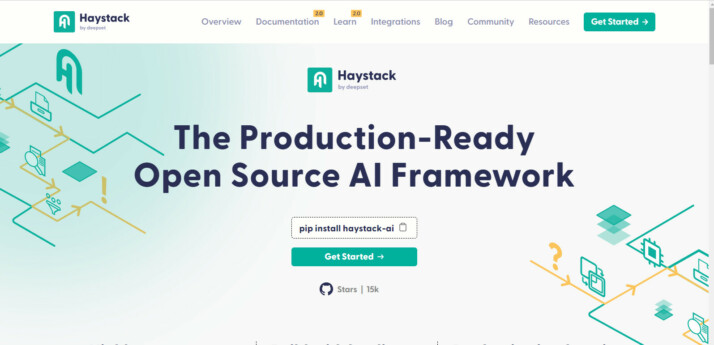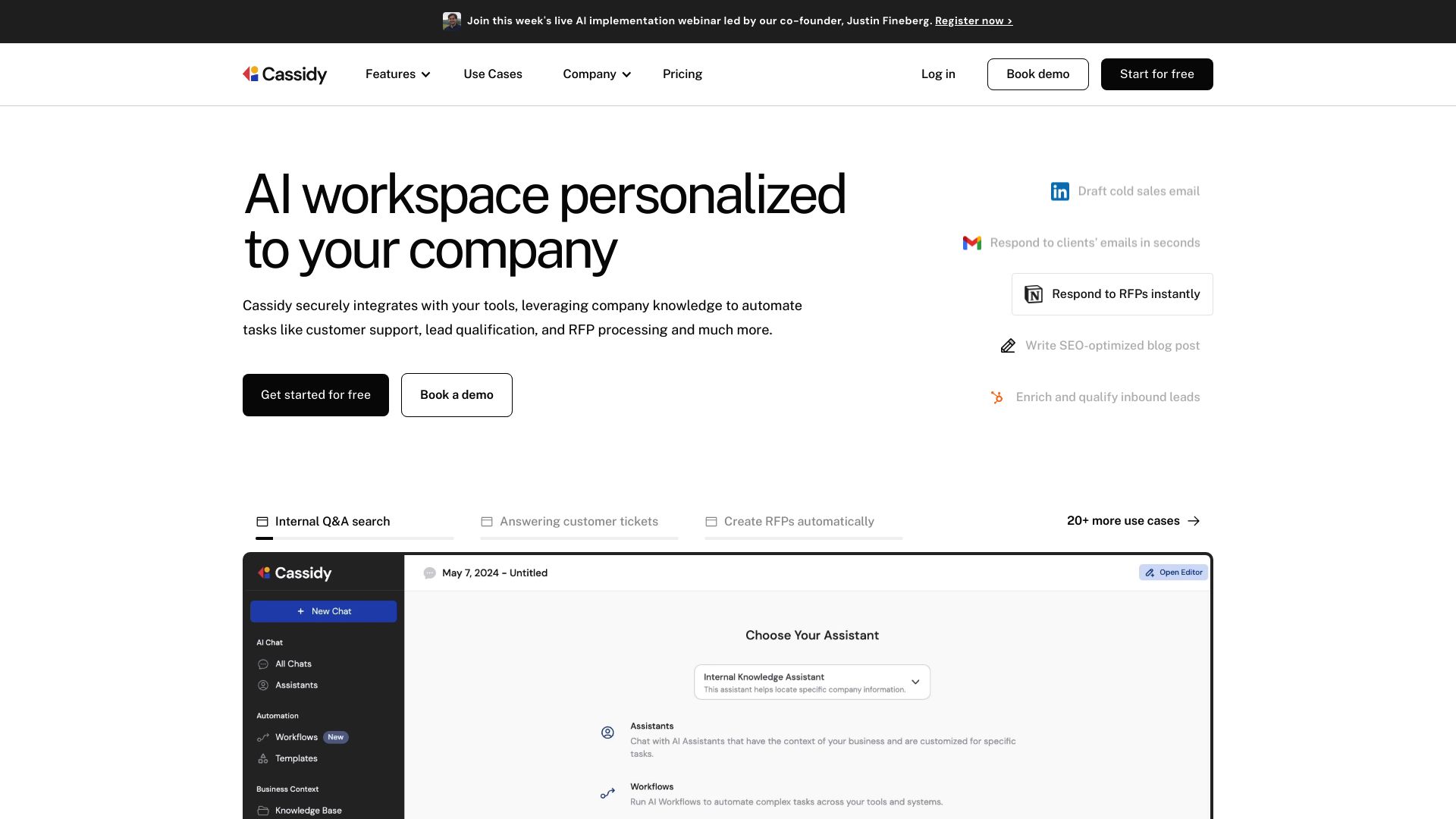Haystack vs. Cassidy: Which AI Platform Reigns Supreme?
AI development platforms Haystack vs. Cassidy offer powerful tools for building intelligent applications, but SmythOS surpasses both with its comprehensive feature set and user-friendly design. This comparison examines how each platform tackles AI agent creation, deployment, and integration. We’ll explore their strengths in areas like natural language processing, workflow automation, and enterprise security. By evaluating core capabilities, development approaches, and real-world applications, we’ll reveal why SmythOS stands out as the superior choice for businesses and developers seeking to harness AI’s full potential. Whether you’re a seasoned AI engineer or new to the field, this analysis will help you select the platform best suited to transform your ideas into production-ready AI solutions.
Haystack Overview
Haystack is an open-source framework for building production-ready applications using Large Language Models (LLMs) and Transformer models. It excels in tasks like retrieval-augmented generation, document search, and question answering. Haystack’s modular design allows developers to create custom search experiences and conversational chatbots by integrating tools such as Hugging Face Transformers, Elasticsearch, and OpenAI into flexible pipelines.


Developed by deepset GmbH, Haystack caters to developers, data scientists, and businesses seeking to leverage AI for improved efficiency and innovation. The framework supports a wide range of use cases, from enhancing customer support with intelligent chatbots to automating complex data analysis tasks in research and development.
Haystack’s key features include support for AI agents, multimodal capabilities, and integration with various foundational AI models. The platform enables developers to build applications that can understand context, maintain memory across interactions, and collaborate with other AI agents to solve complex problems. Haystack also provides tools for explainable AI, ensuring transparency in decision-making processes.
Haystack’s key features include support for AI agents, multimodal capabilities, and integration with various foundational AI models.
While Haystack offers powerful capabilities, it primarily targets users with coding experience. The platform lacks a visual builder or no-code editor, which may limit accessibility for non-technical users. However, this focus on code-based interaction allows for greater customization and control over AI agent development.
Haystack integrates seamlessly with popular tools and platforms in the AI ecosystem. It supports deployment as APIs and webhooks, enabling easy incorporation into existing workflows and applications. The framework’s compatibility with various data formats, including PDFs and Word documents, enhances its versatility in handling diverse information sources.
In the competitive landscape of AI development tools, Haystack stands out for its open-source nature, flexibility, and robust support for advanced NLP tasks. While it may require more technical expertise compared to some alternatives, Haystack’s powerful features and active community make it a strong choice for organizations looking to build sophisticated AI-powered applications.
Cassidy Overview
Cassidy specializes in creating AI automations and assistants tailored to specific business needs. The platform integrates securely with existing tools and leverages company knowledge to automate tasks like customer support, lead qualification, and RFP processing. This personalized approach enhances productivity by equipping AI assistants and workflows with full context specific to each business.
Cassidy specializes in creating AI automations and assistants tailored to specific business needs… leverages company knowledge to automate tasks like customer support, lead qualification, and RFP processing.


Cassidy’s platform stands out with its model-agnostic approach, allowing users to employ any foundational AI model. This flexibility future-proofs AI strategies and enables businesses to adapt as technology evolves. The system seamlessly integrates with various data sources, including Google Drive, Slack, and Notion, facilitating smooth incorporation into existing workflows.
Cassidy’s platform stands out with its model-agnostic approach, allowing users to employ any foundational AI model. This flexibility future-proofs AI strategies…
Security remains a top priority for Cassidy, with enterprise-grade measures ensuring data confidentiality. The platform never uses client data for model training, maintaining strict privacy standards. For users seeking accessibility, Cassidy offers a user-friendly workflow builder with a no-code, drag-and-drop interface for creating complex AI automations.
Cassidy extends its AI capabilities beyond the platform with browser extensions, bringing AI assistance directly into web applications like LinkedIn and email clients. This feature enhances productivity by providing context-aware AI support across various online tools.
While Cassidy offers robust features for AI automation and integration, it may face challenges in highly specialized or niche industries that require extensive customization. The platform’s strength lies in its accessibility and broad applicability, but users with extremely specific or technical requirements might need to evaluate if the system can fully accommodate their unique needs.
Feature Comparison
Haystack and Cassidy offer distinct approaches to AI agent development, with notable differences in their core components and security features. Haystack provides a robust open-source framework for building production-ready NLP applications, while Cassidy focuses on creating customized AI automations for specific business needs.
In terms of core components, Haystack excels with its support for AI agents that can use tools to resolve complex queries and tasks. It offers a comprehensive framework for developing and deploying AI applications across various environments. However, Haystack lacks a visual builder or no-code editor, which may limit accessibility for non-technical users. In contrast, Cassidy provides a user-friendly workflow builder with a no-code, drag-and-drop interface, making it more accessible to a broader range of users.
Regarding security features, both platforms prioritize data protection, but their approaches differ. Cassidy emphasizes enterprise-grade security measures, ensuring data confidentiality by never using client data for model training. Haystack, while supporting data encryption and OAuth authentication, does not explicitly mention features like constrained alignment or IP control. This gap in security specifics may be a concern for organizations with stringent data protection requirements.
Feature Comparison Table
| Haystack | Cassidy | SmythOS | |
|---|---|---|---|
| CORE FEATURES | |||
| Visual Builder | ❌ | ✅ | ✅ |
| No-Code Options | ❌ | ✅ | ✅ |
| Autonomous Agents | ✅ | ❌ | ✅ |
| Explainability & Transparency | ✅ | ❌ | ✅ |
| Multimodal | ✅ | ❌ | ✅ |
| Multi-Agent Collaboration | ✅ | ❌ | ✅ |
| Audit Logs for Analytics | ✅ | ❌ | ✅ |
| Agent Work Scheduler | ❌ | ✅ | ✅ |
| SECURITY | |||
| Constrained Alignment | ❌ | ✅ | ✅ |
| IP Control | ❌ | ❌ | ✅ |
| COMPONENTS | |||
| Huggingface AIs | ✅ | ❌ | ✅ |
| Zapier APIs | ❌ | ✅ | ✅ |
| Classifiers | ✅ | ❌ | ✅ |
| Data Lakes | ❌ | ❌ | ✅ |
| DEPLOYMENT OPTIONS (EMBODIMENTS) | |||
| Staging Domains | ❌ | ❌ | ✅ |
| Production Domains | ❌ | ❌ | ✅ |
| API Authentication (OAuth + Key) | ✅ | ❌ | ✅ |
| Deploy as Site Chat | ✅ | ❌ | ✅ |
| Deploy as Scheduled Agent | ❌ | ✅ | ✅ |
| Deploy as GPT | ✅ | ❌ | ✅ |
| DATA LAKE SUPPORT | |||
| Hosted Vector Database | ✅ | ❌ | ✅ |
| Sitemap Crawler | ❌ | ❌ | ✅ |
| YouTube Transcript Crawler | ❌ | ❌ | ✅ |
| URL Crawler | ✅ | ❌ | ✅ |
Best Alternative to Haystack and Cassidy
SmythOS emerges as a superior alternative to Haystack and Cassidy, offering a comprehensive agentic AI automation platform. Our solution combines ease of use, extensive features, and unlimited use cases, making it the ideal choice for businesses and developers.
SmythOS outshines competitors with its intuitive drag-and-drop interface, allowing users to build complex AI workflows without extensive coding knowledge. This visual approach democratizes AI development, enabling a broader audience to create sophisticated agents quickly and efficiently.
SmythOS outshines competitors with its intuitive drag-and-drop interface, allowing users to build complex AI workflows without extensive coding knowledge.
Our platform boasts an unparalleled feature set, addressing critical gaps left by Haystack and Cassidy. SmythOS supports autonomous agents, multi-agent collaboration, and explainable AI—capabilities not fully realized in competing platforms. We provide robust multimodal support, enabling AI agents to handle various data types, including text, images, and more. This versatility opens up a world of possibilities for businesses across industries.
SmythOS excels in deployment flexibility, offering options that Haystack and Cassidy lack. Our platform allows users to deploy AI agents as APIs, webhooks, scheduled tasks, or even integrate them directly into popular platforms like ChatGPT. This adaptability ensures that SmythOS can seamlessly fit into any existing workflow or tech stack.
Unlike our competitors, SmythOS provides a complete ecosystem for AI development and deployment. We offer staging and production environments, a hosted vector database, and advanced security features like constrained alignment and IP control. These enterprise-grade capabilities, combined with our user-friendly interface, make SmythOS the ideal choice for businesses of all sizes looking to harness the power of AI without compromising on security or scalability.
Conclusion
Haystack and Cassidy offer powerful AI development tools, each with unique strengths. Haystack’s open-source framework excels in building sophisticated NLP applications, while Cassidy’s user-friendly platform focuses on business-specific AI automations. Both provide valuable solutions for different user needs.
However, SmythOS stands out as the superior choice, combining the best of both worlds and offering additional advantages. Our platform’s intuitive drag-and-drop interface allows for rapid AI agent development without sacrificing customization. We support over 300,000 integrations, enabling seamless connection with existing tools and workflows. SmythOS’s ’Create Once, Deploy Anywhere’ approach ensures maximum flexibility, allowing deployment across various platforms and services.
For those seeking to harness AI’s full potential, SmythOS provides the ideal solution. Our platform empowers users to create sophisticated AI agents quickly and efficiently, revolutionizing workflows across industries. Explore our diverse range of AI-powered agent templates to jumpstart your AI journey, or dive into our comprehensive documentation to learn more about our capabilities. Get started with SmythOS today and experience the future of AI development.
Last updated:
Disclaimer: The information presented in this article is for general informational purposes only and is provided as is. While we strive to keep the content up-to-date and accurate, we make no representations or warranties of any kind, express or implied, about the completeness, accuracy, reliability, suitability, or availability of the information contained in this article.
Any reliance you place on such information is strictly at your own risk. We reserve the right to make additions, deletions, or modifications to the contents of this article at any time without prior notice.
In no event will we be liable for any loss or damage including without limitation, indirect or consequential loss or damage, or any loss or damage whatsoever arising from loss of data, profits, or any other loss not specified herein arising out of, or in connection with, the use of this article.
Despite our best efforts, this article may contain oversights, errors, or omissions. If you notice any inaccuracies or have concerns about the content, please report them through our content feedback form. Your input helps us maintain the quality and reliability of our information.
